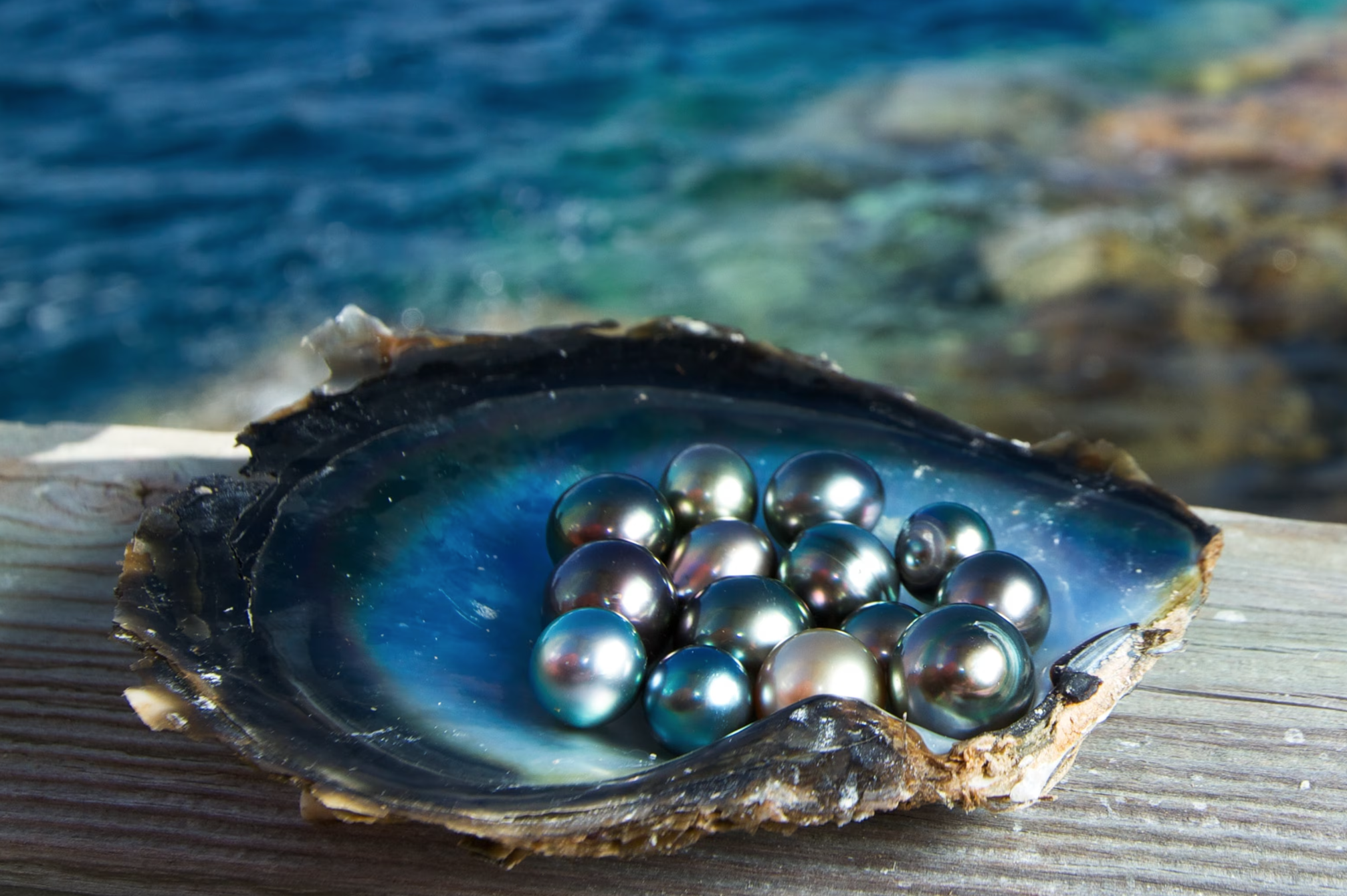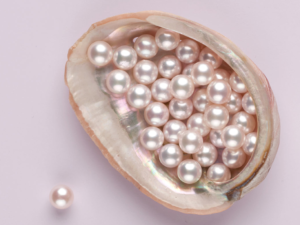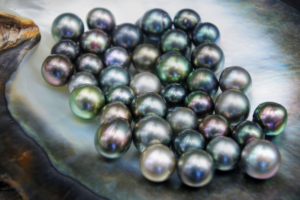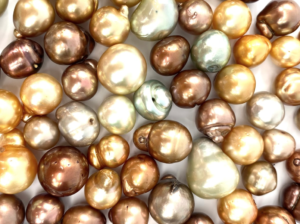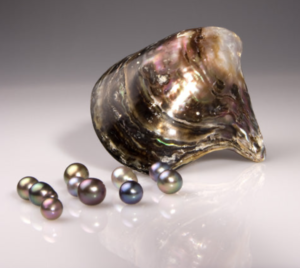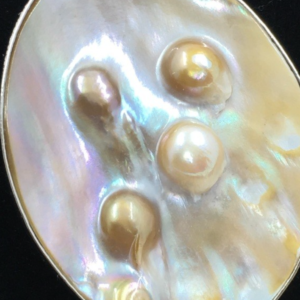Pearls have captivated humanity for centuries, adorning everything from ancient royalty to modern celebrities. But these gems aren’t simply mined from the ocean floor. Today, most pearls are cultured, meticulously cultivated by humans within mollusks like oysters and mussels. This process allows for a wider variety of colors, sizes, and shapes than ever before.
This guide will delve into the fascinating world of cultured pearls. We’ll explore the five main types: Akoya, Tahitian, Freshwater, South Sea, and Sea of Cortez. Each boasts unique characteristics, from the classic white luster of Akoya to the dramatic hues of Tahitian pearls. We’ll uncover the secrets behind their colors, the factors that influence their shapes, and the varying cultivation times needed to produce these precious gems.
But pearls go beyond the standard round gems you might imagine. We’ll also explore lesser-known types like Keshi pearls, which form naturally within mollusks without human intervention, and Mabe pearls, known for their mesmerizing iridescent glow. Baroque pearls, with their irregular shapes, will be explored as well, showing how their individuality can add a touch of artistry to any piece. So, dive in and discover the wonders of cultured pearls, from their origins to their dazzling beauty.
Akoya Pearls:
Origin: These are the most familiar type of saltwater cultured pearl. They are primarily cultivated in Japan, but also in China and Vietnam. Akoya oysters (Pinctada fucata martensii) thrive in shallow waters and are known for their ability to produce high-quality pearls.
Color: Akoya pearls are known for their classic white or cream color, with occasional rosy or greenish hues. This coloration is due to the presence of white pigments called conchiolin and aragonite in the nacre layer deposited by the oyster.
Luster: Akoya pearls are prized for their exceptionally high luster, which is a measure of their brilliance and iridescence. This is a result of the tight layering of the nacre, which creates a smooth surface that reflects light efficiently.
Shape: Akoya pearls are typically round, the most sought-after shape due to its rarity and classic elegance. This is often achieved by implanting a perfectly round bead nucleus into the oyster. However, baroque (irregular) shapes can also occur.
Size: Akoya pearls are typically smaller than other types of cultured pearls, ranging from 2 to 8 millimeters in diameter. Smaller Akoya pearls are more common, with larger, perfectly round ones being exceptionally valuable.
Cultivation Time: It takes about 1 to 2 years to cultivate Akoya pearls. The exact cultivation time depends on the desired pearl size and quality.
Tahitian Pearls:
Origin: Also known as black pearls, Tahitian pearls are a type of saltwater cultured pearl produced by black-lipped oysters (Pinctada margaritifera) found in French Polynesia, particularly around the islands of Tahiti and Rangiroa.
Color: Tahitian pearls come in a wider variety of colors compared to Akoya pearls. While black is the most iconic color, they can also range in shades of gray, green, and even blue. These unique colors arise from a combination of pigments produced by the oyster, such as melanin (black), and the iridescence caused by the light refracting through the nacre layers.
Luster: Tahitian pearls possess a high luster, though generally not quite as high as Akoya pearls. This gives them a unique depth and warmth that complements their darker colors.
Shape: Tahitian pearls are often baroque in shape, meaning they are not perfectly round. This irregularity can range from slightly off-round to highly baroque with distinctive shapes. Baroque Tahitian pearls are treasured for their individuality and organic beauty.
Size: Tahitian pearls can range in size from 8 to 14 millimeters in diameter, with larger specimens being particularly valuable.
Cultivation Time: It takes 2 to 3 years to cultivate Tahitian pearls. The cultivation process requires skilled techniques to nurture the oysters and encourage the development of high-quality pearls.
Freshwater Pearls:
Origin: Freshwater pearls are the most common and affordable type of pearl. They are cultured in freshwater mussels (various species of Hyriopsis) found in lakes and rivers in China, Japan, the United States, and Europe.
Color: Freshwater pearls come in a wider variety of colors than saltwater pearls. They can range from white, cream, pink, lavender, and even black (although dyed black freshwater pearls are more common). The colors arise from a combination of pigments secreted by the mussel and the way light interacts with the layers of nacre. For example, pink freshwater pearls often get their color from a pigment called conchiolin.
Luster: Freshwater pearls can have a good luster, but it is generally not as high as that of Akoya or Tahitian pearls. Their nacre layers tend to be thicker and less compact, resulting in a softer, more diffused luster that some describe as satiny or milky. However, advancements in culturing techniques have led to higher-quality freshwater pearls with improved luster in recent years.
Shape: Freshwater pearls can come in a wider variety of shapes compared to saltwater pearls. This is because the nucleus implanted in the mussel can be manipulated to a greater degree, and the mussels themselves tend to deposit nacre more freely. Common shapes include round, button (flattened on one side), oval, and baroque (irregular).
Size: Freshwater pearls are typically smaller than saltwater pearls, ranging from 2 to 10 millimeters in diameter. However, due to the ease and speed of cultivation, larger freshwater pearls can be produced more readily than large saltwater pearls.
Cultivation Time: It takes only a few months to a year to cultivate freshwater pearls. This faster cultivation time makes them a more affordable option compared to other pearl types.
South Sea Pearls:
Origin: South Sea pearls are the largest and most valuable type of cultured pearl. They are cultivated in large oysters (Pinctada maxima and Pinctada margaritifera) found in the waters of Southeast Asia and Australia.
Color: South Sea pearls come primarily in white and golden colors, with occasional pinkish or silver hues. The white color arises from the presence of white aragonite crystals in the nacre, while golden hues are caused by a combination of yellow conchiolin pigments and light interference within the nacre layers. South Sea pearls are known for their exceptional clarity and brilliance, allowing the light to penetrate deep within the nacre and reflect back out.
Luster: South Sea pearls possess an exceptionally high luster, often described as mirror-like or orient. This is a result of the thick layers of dense nacre deposited by the oysters, creating a smooth surface for light reflection.
Shape: South Sea pearls can be round, baroque, or oval in shape. Round South Sea pearls are the most valuable due to their rarity and classic beauty. However, baroque South Sea pearls can also be magnificent, with unique shapes and a play of light and color.
Size: South Sea pearls are the largest type of cultured pearl, ranging in size from 8 to 20 millimeters in diameter, with specimens above 13 millimeters considered exceptionally valuable. Their large size, combined with their high luster and superior quality, make South Sea pearls the most prestigious and expensive cultured pearls.
Cultivation Time: It takes 2 to 7 years to cultivate South Sea pearls. The extended cultivation period is necessary for the oysters to produce thick nacre layers and large pearls. The slower growth rate also contributes to the higher value of these pearls.
Sea of Cortez Pearls:
Origin: Sea of Cortez pearls are a relatively new type of cultured pearl cultivated in the Sea of Cortez, located off the coast of Mexico. They are produced by the winged oyster (Pteria sterna)
Sea of Cortez Pearl Oyster
Color: Sea of Cortez pearls come in a variety of colors, including white, cream, pink, and gold. These colors arise from a combination of pigments secreted by the oyster and the way light interacts with the nacre layers. For instance, pink Sea of Cortez pearls often receive their color from the pigment conchiolin.
Luster: Sea of Cortez pearls can have a good luster, ranging from high to somewhat variable. The luster develops based on the specific oysters and culturing techniques used.
Keshi Pearls:
Origin: Keshi pearls are a unique type of cultured pearl that are not formed around a nucleus implanted by humans. Instead, they develop as a result of a microscopic irritant, such as a piece of shell or tissue, that gets lodged within the oyster’s mantle. The oyster reacts by secreting nacre around the irritant, eventually forming a pearl.
Characteristics: Because they are not nucleated, keshi pearls tend to be baroque (irregular) in shape, often with a bumpy or organic surface. They can vary in size and color, depending on the oyster species and the irritant that caused them.
Rarity and Value: Keshi pearls are rarer than nucleated cultured pearls due to their unpredictable formation. However, their unique appearance and natural beauty make them prized by some pearl enthusiasts. Their value depends on their luster, color, size, and overall aesthetic appeal.
Natural Pearls:
Origin: Natural pearls are extremely rare and valuable today. They form entirely without human intervention, occurring when an irritant enters a wild oyster or mollusk in its natural habitat. The mollusk reacts by depositing nacre around the irritant over many years, slowly creating a pearl.
Characteristics: Due to the lack of human control, natural pearls are almost always baroque in shape and can exhibit a wide range of colors and blemishes. Historically, they were the only known type of pearl and were highly sought after by royalty and the wealthy elite.
Rarity and Value: The discovery of natural pearls today is very uncommon. They are considered collector’s items and can fetch extremely high prices depending on their size, luster, color, and historical significance.
Mabe Pearls:
Origin: Mabe pearls are a unique type of cultured pearl that form against the inner shell of a mollusk, usually a mollusk species of the Pteria genus. Unlike most pearls, mabe pearls don’t have a full nacreous core. Instead, they develop as a hemispherical blister on the shell’s inner surface.
Characteristics: Mabe pearls have a flat back and a domed top with a vibrant iridescent sheen. This iridescence, often called orient, is particularly strong in mabe pearls due to the way light interacts with the thicker nacre layer deposited against the shell. Their colors can range from white and cream to black and gold, with a distinct metallic luster.
Use: Mabe pearls are not often drilled and strung as beads due to their flat back. Instead, they are often used as cabochons in jewelry designs, taking advantage of their iridescent surface and unique shape.
Baroque Pearls:
Description: Baroque pearls are a broad category encompassing any pearl that is not perfectly round. This includes a wide variety of shapes, such as oval, button (flattened on one side), teardrop, and irregular shapes with multiple undulations.
Formation: Baroque pearls can form in both cultured and natural pearls. In cultured pearls, baroque shapes can arise from several factors, such as the use of an irregularly shaped nucleus or the mollusk’s natural reaction to the implant. In natural pearls, the shape is entirely determined by the mollusk’s reaction to the irritant and the available space within the shell.
Value: Traditionally, perfectly round pearls were considered the most valuable. However, appreciation for baroque pearls has grown in recent years. Baroque pearls can be highly valuable if they possess good luster, attractive colors, and interesting shapes that lend themselves to unique jewelry designs.
